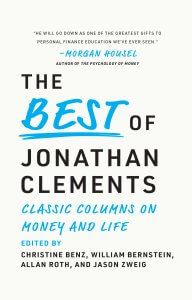FREE NEWSLETTER
If we start lying to others about the state of our finances, we likely stopped telling ourselves the truth years earlier.
 I’d love to take credit for all of this, but my involvement has been modest. After my cancer diagnosis, there was a move to establish a journalism award in my honor. I suggested the savings initiative instead. The heavy-lifting was then done by five luminaries of the personal-finance world: Christine Benz, Bill Bernstein, Karen Damato, Mike Piper and Allan Roth. I consider all five to be friends, and all have some involvement with the John C. Bogle Center for Financial Literacy. Also working on the initiative are two other groups: J-PAL North America and the City of Boston’s Summer Youth Employment Program. Meanwhile, the fine folks at publisher Harriman House assisted with the book's design, and The Wall Street Journal allowed my old columns to be reprinted at no cost. Indeed, the program is being supported by both the Dow Jones Foundation and News Corp., the Journal’s publisher. You can read more about the savings initiative here, and also in Jason Zweig’s Wall Street Journal article from earlier today. Just to be clear, I’m not making any money from the book, and nor are any of the other participants. Want to pitch in? There are two ways: I don’t know of any other program that takes young adults and gets them so directly involved in the financial markets, providing not just the money to get started, but also the investment vehicle as well. Will it lead some of these young adults to become regular savers and investors? If it does, lives will have been transformed. How cool is that?
I’d love to take credit for all of this, but my involvement has been modest. After my cancer diagnosis, there was a move to establish a journalism award in my honor. I suggested the savings initiative instead. The heavy-lifting was then done by five luminaries of the personal-finance world: Christine Benz, Bill Bernstein, Karen Damato, Mike Piper and Allan Roth. I consider all five to be friends, and all have some involvement with the John C. Bogle Center for Financial Literacy. Also working on the initiative are two other groups: J-PAL North America and the City of Boston’s Summer Youth Employment Program. Meanwhile, the fine folks at publisher Harriman House assisted with the book's design, and The Wall Street Journal allowed my old columns to be reprinted at no cost. Indeed, the program is being supported by both the Dow Jones Foundation and News Corp., the Journal’s publisher. You can read more about the savings initiative here, and also in Jason Zweig’s Wall Street Journal article from earlier today. Just to be clear, I’m not making any money from the book, and nor are any of the other participants. Want to pitch in? There are two ways: I don’t know of any other program that takes young adults and gets them so directly involved in the financial markets, providing not just the money to get started, but also the investment vehicle as well. Will it lead some of these young adults to become regular savers and investors? If it does, lives will have been transformed. How cool is that?  Jonathan Clements is the founder and editor of HumbleDollar. Follow him on X @ClementsMoney and on Facebook, and check out his earlier posts. [xyz-ihs snippet="Donate"]
Jonathan Clements is the founder and editor of HumbleDollar. Follow him on X @ClementsMoney and on Facebook, and check out his earlier posts. [xyz-ihs snippet="Donate"] Adam M. Grossman is the founder of Mayport, a fixed-fee wealth management firm. Sign up for Adam's Daily Ideas email, follow him on X @AdamMGrossman and check out his earlier articles. [xyz-ihs snippet="Donate"]
Adam M. Grossman is the founder of Mayport, a fixed-fee wealth management firm. Sign up for Adam's Daily Ideas email, follow him on X @AdamMGrossman and check out his earlier articles. [xyz-ihs snippet="Donate"]NO. 54: WE NEED to be great savers to amass enough for retirement. But we shouldn’t get so good at saving money that, once we’re financially successful, we can’t bring ourselves to spend.
LOOK FOR INSURANCE gaps. Many folks agonize over whether their policies are too large or small. A bigger danger: not having coverage at all, because our life has changed but our insurance hasn’t kept up. Just had kids? It’s time for life insurance. Grown wealthy? Consider umbrella insurance. Working for yourself? You may need disability coverage.
NO. 50: WE LIKE owning assets we can see and touch—but that doesn’t mean they’re good investments. Go back a few generations, and folks put great value on art, jewelry, fine furniture and land. But most tangible assets haven’t been good investments in recent decades. Homes are the exception, but they’re also a big, undiversified risk that come with high costs.
NO. 37: IF INFORMATION is publicly available, it’s hard to make money from it. As soon as news breaks—whether it’s economic or otherwise—investors trade on the information, so it’s almost instantly reflected in stock and bond prices. True, you could get an edge by better analyzing that public information than other investors. But how likely is that?
NO. 54: WE NEED to be great savers to amass enough for retirement. But we shouldn’t get so good at saving money that, once we’re financially successful, we can’t bring ourselves to spend.
WE JUST PURCHASED a new car. The whole buying process has been upended by the pandemic and today’s chip shortage, and we learned seven important lessons.
My wife and I view car buying as an unavoidable chore. We know financial experts recommend buying a car that’s a few years old, so someone else takes the big hit on the initial depreciation. We haven’t done that. We like to buy a new vehicle and keep it for 15 or 20 years.
My 2014 Honda Accord hit 10 years recently. It has 97,000 miles. It still runs well; cosmetically it is average. I use it as a 2nd car. We use my wife’s 2022 Honda Pilot for the majority of our driving. It’s a fine car, but not exciting.
I bought this Accord when I was driving from Valley Forge, PA to northern VA frequently. But that stopped after a few years when my company role changed. I probably put on half the mileage in the first two years.
“NEVER BORROW MONEY to buy a depreciating asset.” This personal finance tip is often used to dissuade folks from taking out car loans. But does a car really leave folks poorer?
When we value an asset, it’s typically thought of as its dollar value on a balance sheet. The monetary value of my car might indeed decline, and quickly at that, but it has far more usefulness than my personal balance sheet shows. When I consider my car’s true value,
LIKE MOST PEOPLE, owning a car is my second largest monthly expense, right after housing. But unlike a lot of people, I also strive to be a super-saver, loosely defined as folks who max out their retirement accounts each year. That means I’m constantly looking for ways to cut my transportation costs.
Four years ago, when I found myself needing to buy a car, I settled on a gently used Honda CRV. Even though it was nearly six years old when I purchased it,
OKINAWA IS A JAPANESE island that is southeast of mainland Japan and about two hours and 40 minutes from Tokyo by plane. It is famous for fierce Second World War battles and currently houses about 26,000 U.S. military personnel. From 2006 to 2008, I was one of these military personnel, working as an emergency physician in the naval hospital.
Okinawa, my new dream come true. Going to Okinawa was not my first choice.
Tax Efficient Investing for Retirees with High Net Worth: Direct Indexing?
Do It for the Kids
Jonathan Clements | May 8, 2025
- Buy copies of the book or purchase the Kindle edition.
- Make a tax-deductible donation.
I don’t know of any other program that takes young adults and gets them so directly involved in the financial markets, providing not just the money to get started, but also the investment vehicle as well. Will it lead some of these young adults to become regular savers and investors? If it does, lives will have been transformed. How cool is that?The Wrong-Sided Man by Dennis Friedman
Let’s revisit an important retirement living topic. How’s it going? Great expectations
Feeling Secure by Jonathan Clements
Generational Perspective
Suffering in Private
Adam M. Grossman | May 3, 2025
The Opposite of HumbleDollar
A Tale of Excess
Don’t Go Breaking My Heart by Marjorie Kondrack
Wall Street Journal Article about Jonathan’s New Initiative
EO 14249 Mandated Electronic Payments